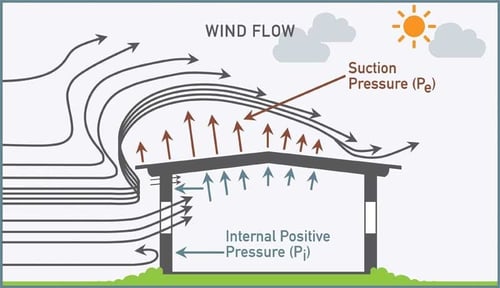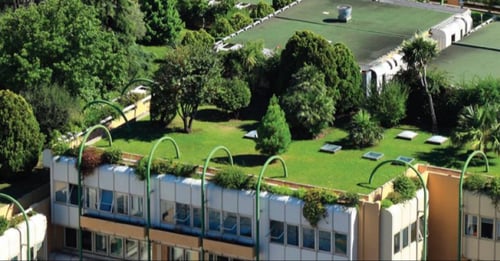Green roofs are an ever-developing technology, with extensive green roofs gaining more and more popularity due to their lightness, versatility and low maintenance requirements. Some, however, fear the weight of extensive systems can be detrimental when it comes to windy conditions, fearing green roofs would not be able to resist the environmental pressures. To explore these questions, let’s take a look at the physics of wind uplift, the research and state of the art.
How Wind Interacts With a Green Roof Surface
According to researcher Karen Liu, PhD, when the wind hits the wall of a building, the air moves upward and increases its speed, producing positive pressure on the wall. The air continues to travel up and over and creates a negative suction on the roof. The distribution of the wind forces is uneven and can be stronger in the corner and edge regions than the field of the roof. This wind-induced suction can harm both the roofing system and the vegetated system, but in two different ways. The roof membrane is impermeable and the suction can cause it to lift like a sail, whereas the vegetated area is permeable, allowing the wind to pass through it and reducing overall uplift (1).
![]()
 Wind flow over building creating suction on the roof. Image: Next Level Stormwater Management (1)
Wind flow over building creating suction on the roof. Image: Next Level Stormwater Management (1)
Wind Forces – Comparing Regular and Greer Roofs
A study comparing a building with a green roof versus one without a green roof indicates that the green roof can reduce the drag force of the building. As explained by the researchers, a green roof could provide about an 8.8% reduction to the building’s drag force and a 9.1% reduction to the roof’s lift force. It’s clear that the major contributor to the reduction of drag force is vegetation. Therefore, the major influence of the green roof appears to be its ability to cut off wind fluctuation near the roof (2).
Weight Versus Wind – Intensive and Extensive Green Roofs
As explained by Karen Liu, intensive green roofs consist of large plantings such as trees and bushes thriving in deep, making them heavy and less lightly to be affected by wind. The growing media with a saturated weight typically ranging from 200 kg/m2 to more than 1000 kg/m2. Despite this, she recommends preventive measures should still be taken on high-rise buildings. For instance, she proposes trees should be anchored to the structural elements to prevent them from blowing off (1).
Extensive green roofs contain small vegetation, such as sedums, grasses, and perennials growing in shallow growing media with design loads typically in the range of 50 to 200 kg/m2. These lightweight systems are, in fact, more affected by wind, and any exposed growing media is prone to displacement, particularly in the corner and edge regions of the roof where localized wind forces are stronger. This can, however, be addressed by introducing measures like control nettings, tackifiers, and hydromulches, or other efficient technical solutions (1).
Therefore, like any building envelope components, vegetated roofing assemblies must be designed properly to resist wind forces to ensure durability and public safety. Designers should ask green roof suppliers for wind resistances of their systems and follow the wind design process to select the appropriate assembly for their projects, Liu adds (3).

How to Design for Wind Resistance?
There is little research available on the topic so far, however, The Toronto Green Roof Construction Standard Supplementary Guidelines (4) offer some design recommendations for planners facing the dangers of strong winds in their green roof planning:
- Use a mechanically attached or fully adhered roof membrane system based on appropriate wind uplift design pressures.
- Use of growth media as ballast against wind uplift for the roofing membrane and other waterproofing elements only where a uniform depth of 200 mm or more is provided; a minimum safety factor of 1.7 should be used for wind uplift calculations.
- Use a minimum of 76 mm of stone ballast in the ballasted areas in the non-vegetated borders, unless greater depths are recommended either by the manufacturer or installer.
- Growth media may be used as a secondary ballast material to ballast the loose-laid roofing components above the waterproofing membrane (i.e., drainage panel, retention mat, root barrier, and insulation board), but not the membrane itself. Use wind uplift design pressures and a minimum safety factor of 0.85 (or as defined by the designer) for wind uplift calculations where growth media is used to ballast.
- Where vegetated, pre-cultivated mats are installed, anchor them until the mat’s root growth has achieved sufficient attachment into the growth media to adequately resist wind action (at least one full growing season). Vegetated mats should be properly anchored or ballasted against wind forces based on a safety factor of 1.0 (or as indicated by the designer).
- Inclusion of Non-Vegetated Border Zones in the areas affected by larger wind pressure (edges and corners). These areas should be free of vegetation and covered by stone ballast or concrete pavers, and have a minimum dimension of 2.6 m. It also limits the installation of green roofs in geographical areas where the wind speed (3 seconds gust) does not exceed 45 m/s, applicable to all building heights.
 Commercial building, Retail Park 2, ZAC des Montagnes, Ouest à Champniers, Photo by Pikt’Air
Commercial building, Retail Park 2, ZAC des Montagnes, Ouest à Champniers, Photo by Pikt’Air
At Urbanscape, we believe the green roofing industry needs to work together with the building industry to determine the best method for testing vegetated roofs in order to help the development of urban green infrastructures in which green roofs play an integral part. Apart from testing, experience also plays a part in our understanding and green roof design. We set up a lightweight green roof (25 kg/m2 = cca 5 lbs/ft2) in an area close to the Slovenian-Italian border, where the strong Bora wind is common, with wind speeds regularly exceeding 200 km/h (120 mph). The roof was set up in the small town of Ajdovščina, where the highest speed ever officially recorded exceeded 300 km/h / 180 mph on 1 November 2010 (Wikipedia). Only two weeks after setting up the green roof, winds close to 160 km/h (100 mph) blew through the area. The roof was left completely undamaged, attesting to the durability and design excellence of our Urbanscape Green Roof System (5)!
Find our more about our successful stories on our website or check our special "Urban Smart Magazine" here.
You can also request a quote for your own Urbanscape Green Roof below:
Sources:
1) Karen Liu, PhD, (2021) Wind design for modular vegetated roofing systems. https://www.constructioncanada.net/wind-design-for-modular-vegetated-roofing-systems/ (published January 28, 2021)
2) Wing-Hong Onyx Wai a, Wen-Qing Hu b, Chi-Wai Li a, Jie-Min Zhan (2015). Effects of green roof on the wind field of a low-rise building, Procedia Engineering 126, 405 – 409
3) Karen Liu, (2021) Wind Design Process for Vegetated Roof Assemblies Using New Standards, https://livingarchitecturemonitor.com/articles/wind-uplift-design-green-roofs-sp21 (published March 29, 2021)
4) Hitesh Doshi et. al. (2017) Toronto Green Roof Construction Standard Supplementary Guidelines, City of Toronto Green Roof Technical Advisory Group, The Office of the Chief Building Official, Toronto Building, City of Toronto. toronto.ca/greenroofs
5) https://www.urbanscape-architecture.com/wind-up-lift-and-wind-resistance-of-green-roofs/



